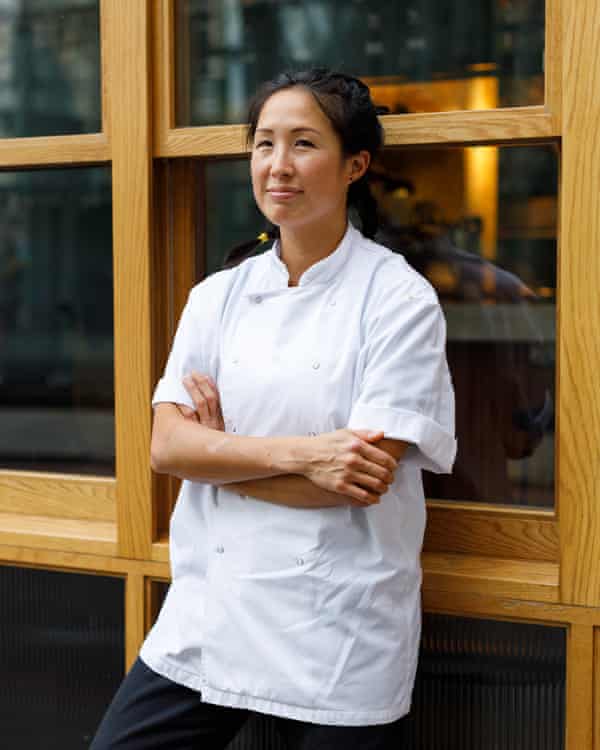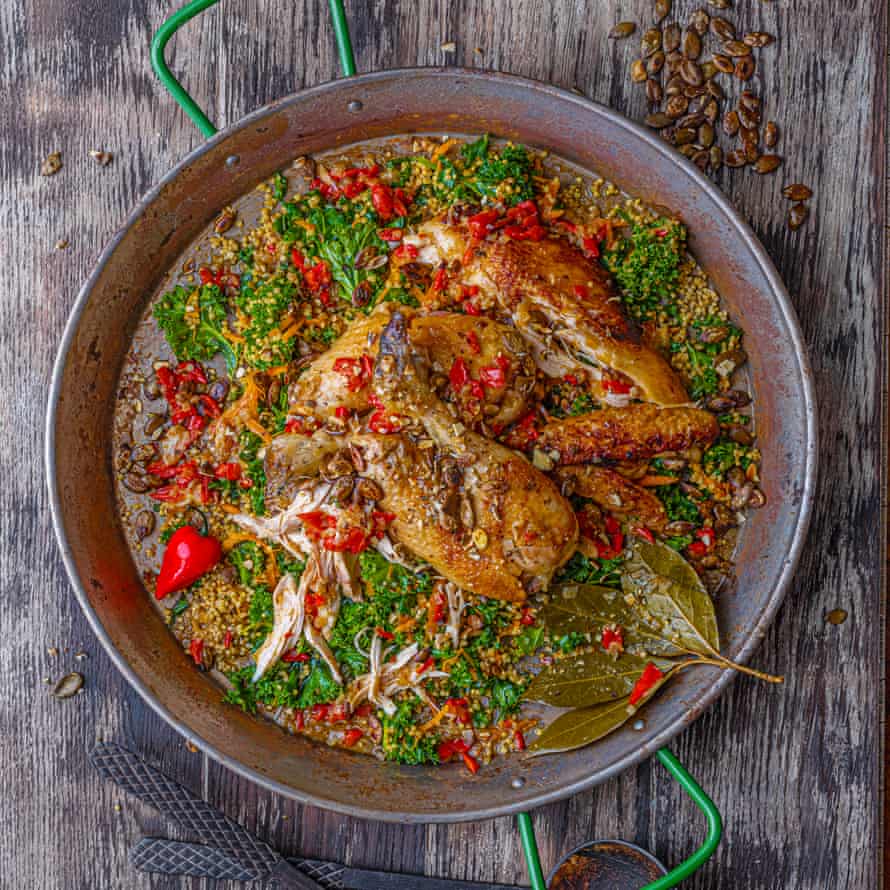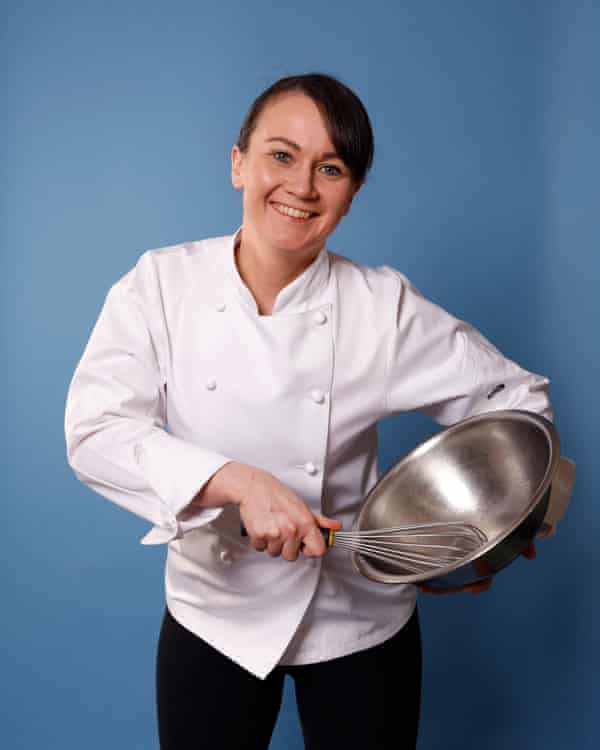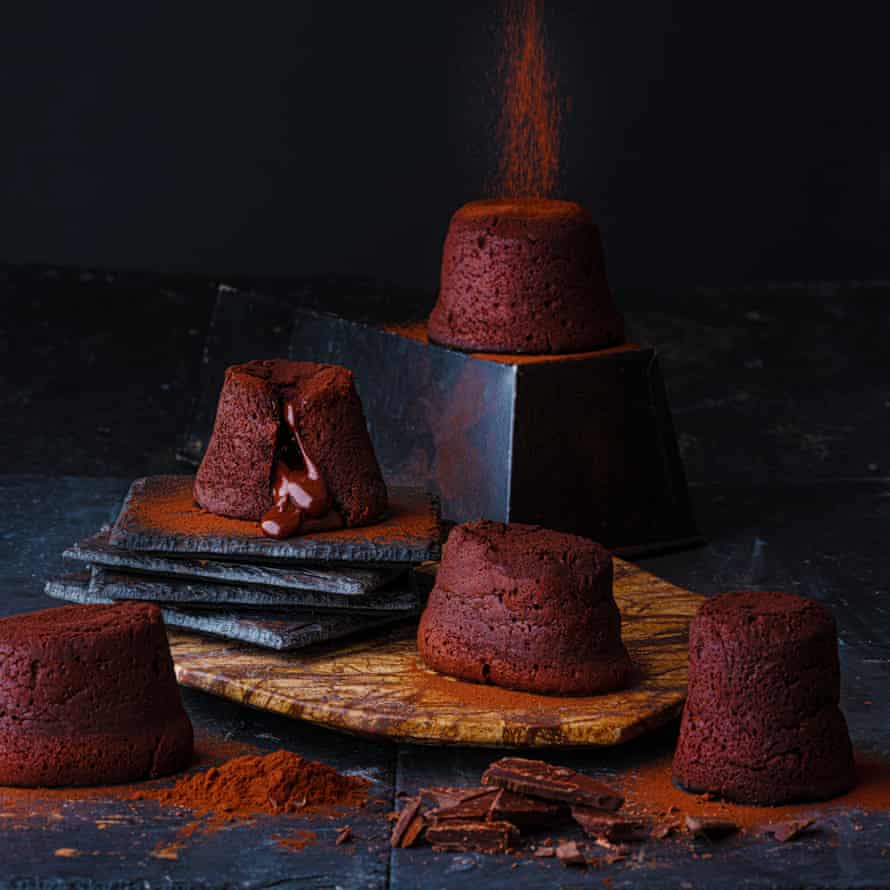Pamela Yung
Head chef at Flor and Asap Pizza, London
Pamela Yung spent much of last year thinking about how restaurants relate to their communities. “This pandemic showed us how important that is,” she says, explaining that the restaurant where she is head chef, Flor, and its sister restaurant, Lyle’s, both relied heavily on travellers. With Flor out of action to dine in, Yung and its chef-owner, James Lowe, executed one of London’s most successful pivots and opened Asap Pizza, making sourdough bases with heritage wheat. “Now we have people who come every week, even multiple times a week,” says Yung.

Lowe met Yung in New York in 2012, when he was there to do an event. Yung was on pastry and Lowe still remembers the bread she made. But he was also impressed by how organised she remained throughout the night’s chaos. “Adaptability is important in a kitchen, and something I value highly.” They stayed in touch while Yung opened Semilla in Brooklyn (since closed), received a Michelin star and was proclaimed the “baddest baker in Brooklyn”. When he came to open Flor in 2019, planned as a wine-bar-bakery, Lowe knew who should lead the kitchen. “She’s an incredibly rare talent,” he says. “She’s never come up with a single idea for Flor that I haven’t thought was perfect.” They also share a passion for creating dishes in order to work with producers whose ideology they respect.
“It is really important to me that I have an impact,” says Yung. She spent part of her lockdown visiting suppliers, furthering her understanding of regenerative agriculture, and she’s keen to get younger chefs thinking about the role of restaurants. “We have a responsibility not just to make nice food but to participate in agriculture and promote sustainability. I see that as part of my mission in life.”
Passatelli in broth with spring greens (pictured above)
This recipe is inspired by two cooks I admire greatly – Mat Lindsay of Sydney’s Ester and Marc-Olivier Frappier of Vin Mon Lapin in Montreal. Marc introduced me to the art of making passatelli, while the broth is inspired by Mat’s parmesan-kombu broth, which I still haven’t been lucky enough to taste.
At the heart of this recipe is cucina povera – humble Italian cooking utilising all the scraps, the sum of which is greater than its parts. Vegetable scraps, parmesan rinds and dried leftover bread are the main components here. While Italian in origin, I put a slightly Japanese spin on it, as in my mind the two cuisines are related in many ways.
I’m the kind of cook who will keep offcuts of any vegetables in the freezer, until there is enough to make a nice vegetable stock. However, if this is not your habit, you can use fresh vegetables. The cheese rinds and kombu round out this fresh and aromatic broth with strong umami notes, and the ribbons of spring greens add textural contrast.
You will need a passatelli maker or a potato ricer to make this rustic “pasta”.
Serves 2
For the broth
onion 1 medium, quartered
carrot 1 large, roughly chopped
celery 3 stalks, roughly chopped
garlic 3 cloves, smashed
dried shiitakes 30g, soaked in hot water for 5 minutes, then drained
parmesan or pecorino rind 2 pieces (about 80-90g)
cold water 750ml
kombu 20g
bay leaf 1
For the passatelli
eggs 2 large
parmesan 100g, finely grated
breadcrumbs 100g, fine
nutmeg a few gratings
salt to taste
For the spring greens
unsalted cultured butter 60g (or regular unsalted butter)
spring greens 100g, sliced crosswise into long ribbons
yellow miso 1 tsp
dried Calabrian chilli ½
garlic 1 clove, crushed
salt
lemon zest and juice of 1
good olive oil to finish
Lay the onion, carrot, celery, garlic and soaked shiitake on a sheet tray and roast at 150C fan/gas mark 3½ for about 1 hour, until shrivelled a bit and lightly caramelised.
Slowly heat the rinds in a small saucepan, on low heat. Allow them to begin to melt and start to caramelise. Cover with the cold water, add the kombu, the bay leaf and the roasted vegetables, and steep at a bare simmer for 2 hours. Remove from heat and strain. Season scantily with salt – this has to complement, not compete with, the saltiness of the parmesan in the passatelli.
Mix everything together for the passatelli – it should be a fairly stiff ball, not at all crumbly, so it can hold its shape while being shaped; not too sticky. If it’s too crumbly, add more egg. If too wet, add more breadcrumbs or cheese.
To cook the passatelli, bring the vegetable broth to a boil. Pinch a golf-ball sized chunk of the passatelli dough, and put it in between the plate and the holed plate of the passatelli maker or potato ricer, and press, like a giant garlic press. Squeeze the passatelli dough to a length of about 5cm over the pan of broth – you can cut it with a knife as it is forced out of the passatelli maker/ricer into the boiling broth. Cook for 4 minutes.
Meanwhile, make the spring greens. Melt the butter in a saucepan, add the yellow miso, chilli and garlic, then quickly saute the greens in the butter sauce. Season with salt and a squeeze of lemon juice.
Serve in warm bowls, with the passatelli, spring greens and enough of the vegetable broth to just cover everything. Finish with some black pepper, a glug of olive oil and a sprinkling of lemon zest.
Hasan Semay
YouTube chef, London
Hasan Semay sits at a table in his London garden, hands in his apron, and side-eyes the camera. “The cold’s got to me.” On one of the chilliest days of the year, Semay – known to his 30,000 Instagram followers as Big Has – is shooting a YouTube recipe tutorial. He warms up as he explains how to kill a lobster, cook it on a camp stove, then make a mayo. A live lobster may be a premium ingredient but Semay isn’t shy in showing off his supermarket rolls.

“I live in the real world,” he laughs. “You live within your means. Some days all I want is Monster Munch and Skittles – but if there’s money in my pocket, I’m always going to spend it on good food.”
Semay’s passion for live fire cooking was ignited in his Turkish-Cypriot household, where Sunday roasts meant Sunday barbecue, whatever the weather. His appreciation for anything delicious and lack of pretension – he often scuffs round in socks and sandals – are reminiscent of Jamie Oliver.
Working as a plumber, then as a security guard, Semay wasn’t happy – until his mother encouraged him to apply for Oliver’s apprenticeship programme in 2012. The kid who had rushed home to watch Ready Steady Cook found his groove. After 13 months’ training, he joined the restaurant industry. But as he rose up the ranks, he loved his job less. “By the time I got to head chef, that point where every loose screw in this big machine is your problem, and all you do is stand at the pass …” He sighs. “I’d just wait for my days off so I could cook my own food.”
He left kitchens in 2019 and worked as a consultant. During lockdown, he designed some meal kits, then concentrated on videos as a way to broadcast his talent, and show people how delicious food is in their reach. “Cooking shows can be elitist,” Semay says. “But if I can do it in my garden, what’s to stop you doing it in your kitchen?”
Now, there’s talk of books, and his mentor, friend and sometime collaborator, has nothing but admiration for what he’s built. “Has is a brilliant communicator,” says Oliver, “obsessed with food in all its forms, and proof that looks can be deceiving – this mighty man is a soft, kind soul. Are you ready for him?” Oliver answers his own question with a resounding “yes”.
Grilled lamb leg, atom yoghurt, dressed tomatoes, and black olive and anchovy flatbreads

This is simply a celebration of ingredients I love. For us Turkish-Cypriots, lamb and charcoal are an everyday thing. I’ve spent almost every Sunday of my life in the back garden in Edmonton alongside my old man watching lamb fat drip on to glowing coals. I’ve also spent most of my career in Italian restaurants working for the likes of Jamie, Theo Randall and Stevie Parle, so I’m basically Italian. I fell in love with the similarities of the flavours across the Mediterranean. Nothing felt too far from home. Deep peppery olive oils, salty shrivelled black olives and the worship of the humble tomato. I guess this dish symbolises who I am as a cook. Yes I’m a big, somewhat scary looking London boy with Turkish roots, but my hands are Italian.
Serves 3
For the atom yoghurt
thick yoghurt 650g (try and get Turkish suzme)
sea salt 5g
sugar 15g
garlic 2 cloves, grated
lemon juice of 1
For the pul biber butter
unsalted premium butter 60g
pul biber 2 tbsp
For the anchovy and black olive flatbread
anchovy fillets 4
pitted black olives 80g
garlic 1 clove
parsley 10g, chopped
lemon juice of 1
good quality olive oil 20ml
flatbreads 3 lavash, pitta or plain naan – or make your own (see below)
For the lamb
rosemary 3 sprigs
garlic 4 cloves
lamb leg 750g (ask the butcher to take the bone out and portion the individual muscles of the leg), or 9 lamb chops
lemon peel of 1
olive oil 15ml
For the tomato salad
mixed tomatoes 200g
salt
shallot 20g, thinly sliced
chives ½ bunch, chopped
mint 2 sprigs
white wine vinegar a splash
olive oil
For the homemade flatbreads (makes 12 pitta-sized)
bread flour 1kg
salt 25g
tepid water 560ml
fresh yeast 30g
sugar 1 tbsp
olive oil 50ml
To make the flatbreads, place the flour and salt in a large bowl and give it a good mix. Make a little well in the middle and set aside. In a jug mix all of the remaining ingredients. It’s important the water isn’t hot or the yeast will be killed. Stir the wet mix together until the yeast is fully dissolved.
In 3 parts, add the wet mix to the dry. I like to stir it using two fingers, and every time the dough starts to stiffen I add a little more liquid. Repeat until the liquid is all added.
Turn the dough out on to a work surface and knead for 15 minutes. Once smooth, place the dough in an oil-lined bowl to prevent it sticking. Prove the dough until it’s doubled in size. Once fully proved, carefully tip it out on to the work surface and portion into 12 equal balls. Place them on an oil-lined tray, cover loosely with a tea towel and let them prove again for 40 minutes or so.
To roll the flatbreads, give the work surface a light dusting of flour. Flatten one of the dough balls with your fingers, trying to keep it as circular as possible. Then use a rolling pin to flatten and stretch the dough. If you like flatbread with a little chew, roll to the thickness of a £2 coin. If you like them a little crispier, roll to the thickness of a 10p coin.
Cook the flatbreads over a grill until they start to puff up like a pitta; once there’s a nice golden colour on the underside, flip it over and spoon on the anchovy and black olive mix. The heat from the bread loosens the oil and give the paste a gentle fry.
The yoghurt is essentially a labneh – a strained yoghurt served as a cold starter in Turkey and the Middle East. I find this recipe works best with a pair of tights, but if you have a cheesecloth or muslin, use that. Spoon the yoghurt into a bowl and add the salt, sugar, garlic and lemon juice. Give it a good mix and scrape it into your fabric. I hang mine in the garden for at least 2 hours and allow gravity to work its magic. The longer the yoghurt is left to hang the stiffer it becomes; we want it to be a cream cheese consistency.
Melt the butter. Just as it starts to smell of butterscotch and has a slight golden colour, add the pul biber. It’s important to catch the butter at the beginning of the brown butter process. If it’s too hot, it will fry off the deep flavours from the pul biber. Give it a little swirl and take it off the heat.
For the flatbread, put the anchovy, olives and garlic in a pestle and mortar and smash it into a smooth paste. You can do this in a food processor, but using a pestle and mortar means the mix doesn’t emulsify and thicken, instead it just brings everything together loosely. Add the chopped parsley and give that a smash too. Next add the lemon juice, then the olive oil.
Heat the flatbreads in a hot pan or outdoors while the lamb rests. Allow them to gain a little bit of colour. Turn them over and smear on the olive and anchovy mix.
Ask your butcher for the eye of the lamb leg with the fat still intact; alternatively you can use chops. To make the lamb, strip back the rosemary and rub it in your hands to bruise it and release its oils. Crush the garlic using the flat side of a knife on a chopping board – don’t bother peeling it, we just want the aromas for the marinade. Add the lemon peel and olive oil, give it all a good mix, coat the lamb with it and marinate in the fridge anywhere between 2 hours and 2 days.
This recipe works best grilled outdoors over charcoal. Set up a barbecue and wait for the coals to glow white. Push some of the coals aside from the area you’re cooking the lamb, leaving some behind. We want a flat, even layer of charcoal – this gives more control and it’s less likely to go up in flames. We don’t want to cook the lamb too hard and fast; we want it to slowly hiss and render, and the fat drips to create clouds of smoke. It’s vital to keep your eye on the meat and turn it consistently. Turn the meat every 2-3 minutes so it cooks evenly. Cook until it has an internal temperature of 48C. Allow the lamb to rest for at least 10 minutes, when the temperature will climb to about 52-54C, giving nice juicy glistening pieces of lamb.
If cooking this in the oven, season the lamb heavily with salt. Preheat the oven to 180C fan/gas mark 6. In a hot cast iron pan, seal the meat all the way round, then stick it in the oven and roast for about 20 minutes.
If you are using lamb chops, cook them on the barbecue, or pan fry or grill. The chops will not need as long as the portioned lamb leg, a few minutes each side. The chops should be browned and caramelised and when you poke the meat it should feel tight and bounce back – like the lower part of your palm below your thumb.
For the tomatoes, cut them inconsistently, some in half, some in quarters and maybe even squash some. Season with salt to release their juices.
Add the shallots, chives, mint and vinegar. Stir everything together and allow to sit for 5 minutes. Before serving add a good glug of olive oil and mix.
To serve, put a nice dollop of labneh on a plate, make a little well with the back of a spoon and add the pul biber butter. Then add a nice little pile of the tomato salad. Then a few slices of beautifully cooked lamb and finish with a couple of wedges of the anchovy flatbread.
Adejoké Bakare
Head chef at Chishuru, London
In 2020, Adejoké Bakare turned 50 and opened her first restaurant, Chishuru. Did the until-then home cook secretly hope she’d be one of London’s most heralded new chefs? “Never in my wildest dreams,” she laughs.

Bakare has always been a feeder. “I want people to feel happy and welcome when they come to my house.” Anyone who has been to Chishuru will recognise that hospitality. It was one of the last places Jay Rayner reviewed before the current lockdown. “What’s striking about Bakare’s food is that it manages to be vivid and fresh while also extremely comforting,” he says. “Her atassi rice felt like a gateway into someone else’s life story. She is cooking dishes from a west African repertoire that has had nowhere near enough attention in the UK.”
About 15 years after moving to the UK in 1999 from Nigeria, Bakare started making pies to sell after church. That turned into hosting supper clubs, to show people in her community the diversity of Nigerian food. She was ready to share her vision further but didn’t know how to set up a restaurant, and wasn’t sure her food would be welcome. A friend said she must start believing in herself, and then came the final ultimatum. “She said, ‘If you don’t do anything by the end of the year, I won’t be your friend any more,’” laughs Bakare. She sat down and wrote a menu to place her identity on a plate, then entered and won a competition to earn a space in Brixton Village.
Competition judge Jackson Boxer didn’t see anything but confidence. From their first meeting, he was won over. “Her food was captivating, and she is an extraordinary person, with such enormous erudition of gastronomy.” Bakare says he’s since become a great friend and champion, inviting her to work alongside him at Brunswick House to get experience in a professional kitchen.
She has only cooked in her own restaurant for a handful of months, but is keen to return. “Success for me will be when west African food becomes more mainstream,” says Bakare. “When people are comfortable enough to go to the west African shops for ingredients, to have egusi and uda accepted in the same way south-Asian ingredients are.”
Chicken kedjenou with millet dambu – chicken stew with millet couscous

Kedjenou is a light chicken and vegetable stew, traditionally cooked in a sealed earthenware pot, so the chicken steams and pressure cooks at the same time. The result is moist and intensely chicken-flavoured. Dambu is the name for a variety of side dishes using either broken rice or millet. It can be an accompaniment for stews or sauce, or is delicious eaten on its own.
Serves 2-4
For the kedjenou
chicken 1 small, or 8 chicken thighs
lemon juice 3 tbsp
salt to taste
vegetable oil 3 tbsp
onion 1 medium, diced
garlic 2 cloves
minced ginger 2 tbsp
red pepper 1, diced
scotch bonnet 1, chopped (to taste)
bay leaf 1
ground anise 1 tsp
selim pepper (uda) 2 pods (optional)
ground white pepper 1 tsp
For the dambu
vegetable oil 3 tbsp
millet 100g
chicken stock 200ml
lemon juice 2 tbsp
yaji spice mix (suya) 1 tsp (or substitute with a pinch each of cumin, cloves and ginger powder)
moringa or kale 85g, finely chopped and massaged with a pinch of salt
carrots 40g, shredded
onion 1 small, finely chopped
peanuts or pumpkin seeds 40g, toasted
salt to taste
Rub the chicken with 2 tablespoons of lemon juice, 1 tablespoon of salt and 2 tablespoon of vegetable oil. Leave to marinate for 2-6 hours. Brown the chicken in a frying pan with the remaining oil.
In a heavy bottom pot, fry the onion, garlic and ginger for 5 minutes in the oil used to brown the chicken. Add the pepper, chilli, spices and seasoning. Arrange the chicken on top, put tin foil over the top of the pan and cover it tightly with the lid. Cook on a gentle heat for 1 hour. Adjust the seasoning with the remaining lemon juice and salt.
Meanwhile, make the dambu. Heat a saucepan, add 2 tablespoons of the oil, and fry the millet grains, stirring constantly to avoid burning. When the grains all turn white add the stock. Steam the millet for 20 minutes, with the lid on. Test for doneness, the grains should be al dente. Let the millet cool, covered, then add the remaining oil and “roll” the grains with your hands in the pot to make sure they are coated and separated. Rolling is how you prepare couscous traditionally, so each grain is coated with oil. Add the lemon juice and spice to the grains and mix. Add the raw moringa, carrot and onion. Season to taste, garnish with the nuts and serve with the chicken.
Lorna McNee
Head chef at Cail Bruich, Glasgow
“There have been lots of big changes,” says Lorna McNee of the past few years, ”but all good ones that needed to happen.” As the winner of the 2019 Great British Menu, she was brought to media and public attention. Then in 2020, she was appointed head chef at Cail Bruich in Glasgow.

McNee had been at Restaurant Andrew Fairlie for 12 years, working up from apprentice to sous chef. She’d learned everything she could and was ready to lead a team – and realise her own culinary vision. “When you’re using someone else’s style you have certain restrictions,” says McNee. “I had so much freedom there, but to put everything on the plate and have it the way you want it, you have to go out on your own.”
When she joined the team of seven at Cail Bruich, lockdown had already begun in Scotland, and they were making meal kits. The return to service in summer and autumn saw McNee’s cooking – with its fine-dining technical precision now given a more modern touch – secure the restaurant a Michelin star, Glasgow’s first in 18 years. Her success was no surprise to anyone familiar with her food.
“Lorna has this way of really touching your heart with her food and also with her energy,” says Andi Oliver, a judge on Great British Menu. “The way she balances flavour is like someone singing a perfect note – she works from her soul, but has this steely determination and will work until she gets things right.” That work ethic is now focused on the future. “All I can hope for right now is a full restaurant,” says McNee. She hopes lockdown in Scotland will be lifted in June. “In a year’s time, I hope I have the same team, and we’re happy and strong and have found our rhythm. In a few years, I’d like to see the restaurant is improving, and getting more accolades.”
Perfect every time chocolate fondant

This is one of those desserts that people think is difficult, but when you have a good recipe it becomes very easy. This is that recipe. It’s a massive favourite in my house and is always served with fresh raspberries and vanilla ice cream. It’s definitely a restaurant dish that can be done at home. It is thought the Michelin-starred chef Michel Bras was the first to make a chocolate fondant.
Serves 6
butter at room temperature or slightly melted
cocoa powder
For the sugar and yolks
castor sugar 57g
egg yolks 100g (about 5 yolks)
For the sugar and eggs
caster sugar 57g
eggs 250g (about 4-5 eggs)
For the chocolate mixture
unsalted butter 250g
dark chocolate 250g, the optimum is 66%, but anything from 62-70%
plain flour 35g
You’ll need 6 x 175ml porcelain or metal ramekins. Brush the butter all over the ramekins, then add a spoon of cocoa powder to each one. Shake it around the ramekins until they are evenly lined. Tap out any excess.
Whisk the sugar and yolks together in an electric mixer until light and fluffy. Whisk the sugar and whole eggs in another bowl until light and fluffy. Melt the butter and chocolate gently in a large bowl over a bain marie. Add the fluffy egg yolk and sugar mix to the chocolate and combine well but not too hard. Fold in the fluffy egg and sugar mix and combine gently. Lastly add the flour.
Spoon or pipe into the ramekins until it reaches the top and then tap it gently on the table until evenly dispersed. Rest for around 30 minutes. When you are almost ready to cook the fondants, heat the oven to 180C fan/gas mark 6. Bake for 9 minutes. Tip the fondant out onto a plate and serve warm with the best vanilla ice-cream and raspberries.
